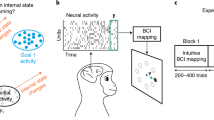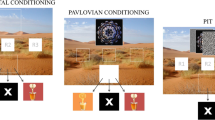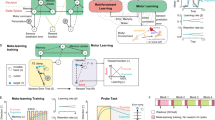Abstract
Perceptual learning can occur as a result of exposure to a subliminal stimulus, without the subject having to pay attention and without relevance to the particular task in hand1 — but is this type of learning purely passive? Here we show that perceptual learning is not passive, but instead results from reinforcement by an independent task2,3. As this learning occurred on a subliminal feature, our results are inconsistent with attentional learning theories4,5 in which learning occurs only on stimuli to which attention is directed. Instead, our findings suggest that the successful recognition of a relevant stimulus can trigger an internal reward6 and give rise to the learning of irrelevant and even subliminal features that are correlated with the occurrence of the reward5,6.
Similar content being viewed by others
Main
In our previous study1, subjects carried out an attentionally demanding letter-identification task7 in the fovea while a coherently moving, random-dot display that was below the visibility threshold was presented in the periphery. Repetitive exposure improved subjects' performance in specifically identifying the direction of this subthreshold motion when tested in a subsequent above-threshold test1. This showed that perceptual learning occurs unconsciously as a result of frequent exposure to an irrelevant feature.
This raises the question of whether subliminal learning occurs only as a result of passive exposure to a stimulus. To test this idea, we presented four different directions of motion an equal number of times during the exposure stage of the experiment, with a 'designated direction' always being 'paired' with the targets of the letter-identification task and the other directions being randomly associated with the letter-task distractors (Fig. 1a). If perceptual learning were due only to passive exposure, motion direction thresholds should improve equally for all of the presented directions. But if learning occurs only for features to which attention is directed, no improvement should be found for any presented direction.
a, Exposure stage, showing the letters used in the main identification task and the direction of motion of background dynamic random-dot displays (DRDs, arrows). Red arrows indicate the 'designated direction' for the motion of the DRD that was presented at the same time as the task targets (two white letters); black arrows indicate the other directions of the DRD, which were paired with the task distractors (six black letters). In the tests1, subjects reported direction of coherent motion of DRDs of 5% and 10%; their performance in the tests was at chance at 5% coherence and better than chance at 10%. In the exposure stage, subjects witnessed DRDs with 5% coherent motion while carrying out the identification task1 on dimmed letters to prevent their attention from disengaging. Letters were presented for 375 ms, centred in a 500-ms DRD. b, Perceptual-learning results (mean for five subjects), showing the difference in performance in tests before and after exposure for each direction (centred on the designated direction) at 5% and 10% coherent DRDs. At 10% coherence (left), there was a significant peak (P < 0.01, analysis of variance) and the identification accuracy for the designated direction (0°) was significantly better than for other directions (P < 0.05, one-tailed t-test versus 0°; P < 0.01 for designated direction versus other directions) for all subjects. At 5% coherence (right), no significant effect was evident.
However, contrary to both situations, the threshold improved for the designated direction paired with the task targets, but not for the other directions, which were paired with distractors (Fig. 1b). Our results indicate learning of an irrelevant and subliminal feature that is positively correlated with target presentation. No evidence of passive learning was found for the other directions of random-dot motion within the exposure period, although we cannot rule out passive learning over longer periods of exposure.
To determine whether the target letters facilitate learning of the designated direction (as in internal reinforcement) or whether the distractor letters inhibit learning of the other directions of motion (as in negative priming8), or both, we carried out a control experiment using new subjects. These new subjects were passively exposed to the stimulus while, as their main task, they were instructed to report the 5% of trials in which they saw the same letter twice in a sequence of black letters. Consistent with the reinforcement learning hypothesis, subjects showed no significant subliminal learning (results not shown). However, the nonsignificant negative trend of distractors in the main study, but not in the control experiment, may indicate that there is a learning-inhibition component.
Although our results are at odds with theories of passive learning and focused attention, they are consistent with classic conditioning results3, in which arbitrary features are learned as a result of pairing with rewarding or noxious stimuli. In our experiment, the motion direction (designated direction) was paired with task targets, the successful recognition of which may generate an internal reward6.
We propose that diffuse reinforcement-learning signals are complementary to focused attention4,5 in subliminal perceptual learning. In reinforcement learning, a reward signal links the neural response with task performance3, whereas focused attention allows knowledge to bias the neural response9 and involves cortical processing. We have shown that presenting a stimulus that is relevant to a task can give rise to an internal reward that works like an external reward in reinforcement learning. This reinforcement signal is probably mediated by neurotransmitters such as acetylcholine, noradrenaline and dopamine from subcortical brain areas, which are widely released in a task-specific manner10 and bring about synaptic plasticity2.
References
Watanabe, T., Náñez, J. E. & Sasaki, Y. Nature 413, 844–848 (2001).
Arnsten, A. J. Neuropharmacol. 11, 151–162 (1997).
Schultz, W. Nature Rev. Neurosci. 1, 199–207 (2000).
Ahissar, M. & Hochstein, S. Proc. Natl Acad. Sci. USA 90, 5718–5722 (1993).
Karni, A. & Sagi, D. in Maturational Windows and Adult Cortical Plasticity, SFI Studies in the Sciences of Complexity (ed. Kovács, B. J. a. I.) 1–15 (Addison-Wesley, Reading, Massachusetts, 1995).
Herzog, M. H. & Fahle, M. Vision Res. 39, 4232–4243 (1999).
Joseph, J. S., Chun, M. M. & Nakayama, K. Nature 387, 805–807 (1997).
Tipper, S. P. & Cranston, M. Q. J. Exp. Psychol. A 37, 591–611 (1985).
Reynolds, J. H., Chelazzi, L. & Desimone, R. J. Neurosci. 19, 1736–1753 (1999).
Dalley, J. W. et al. J. Neurosci. 21, 4908–4914 (2001).
Author information
Authors and Affiliations
Corresponding author
Ethics declarations
Competing interests
The authors declare no competing financial interests.
Rights and permissions
About this article
Cite this article
Seitz, A., Watanabe, T. Is subliminal learning really passive?. Nature 422, 36 (2003). https://doi.org/10.1038/422036a
Issue Date:
DOI: https://doi.org/10.1038/422036a
This article is cited by
-
Neural ensembles in the murine medial prefrontal cortex process distinct information during visual perceptual learning
BMC Biology (2023)
-
Reading text works better than watching videos to improve acuity in a simulation of artificial vision
Scientific Reports (2022)
-
Training with an auditory perceptual learning game transfers to speech in competition
Journal of Cognitive Enhancement (2022)
-
Vision as oculomotor reward: cognitive contributions to the dynamic control of saccadic eye movements
Cognitive Neurodynamics (2021)
-
Perceptually unidentifiable stimuli influence cortical processing and behavioral performance
Nature Communications (2020)
Comments
By submitting a comment you agree to abide by our Terms and Community Guidelines. If you find something abusive or that does not comply with our terms or guidelines please flag it as inappropriate.




